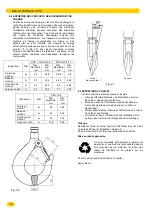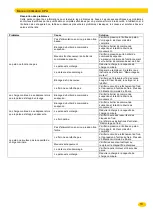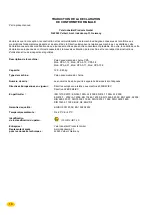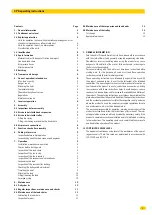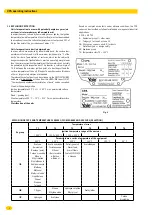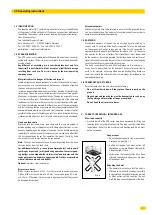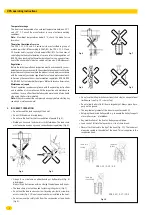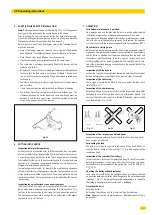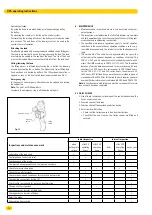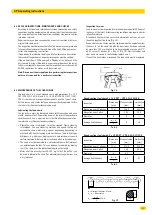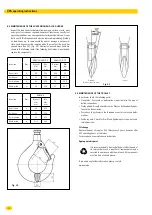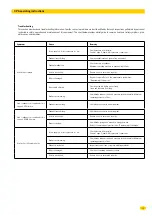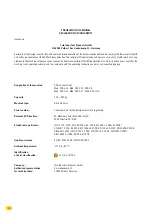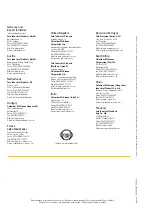
11
CPA operating instructions
8.3 MAINTENANCE OF THE LOAD CHAINS
The load chain is a case hardened chain with dimensions 4 x 12,2
DAT (CPA 1-13/2-10/5-5) and 6,3 x 19,5 DAT (CPA 2-31/5-17/10-9).
CPA air chain hoists are specially designed to use this type of chain.
For this reason only chains that have been specifically approved for this
chain hoist by the manufacturer may be used.
Lubricating the load chain
The load chain must be lubricated before initial operation and each
month, however after 50 operating hours, at the latest. Under extreme
conditions, such as e.g. excessive dust or particularly arduous operation,
the intervals must be shortened accordingly.
• Before the chain is lubricated it must be cleaned. Flame cleaning
is forbidden. Use only cleansing methods and agents that do not
corrode the chain material (e.g. vapour degreasing, degreasing in
alkaline bath). Avoid cleaning methods that can lead to hydrogen
brittleness, e.g. etching or dipping chain in acid solvents; also avoid
surface treatments that can hide cracks and other surface damage.
• The chain must be lubricated in a no-load condition so that lubricant
can enter between the links. This can be done, for example, by dipping
in oil. The chain must be lubricated along its entire length.
• Motor oil of the viscosity class VG 100, e.g. SHELL Tonna T68, can
be used to lubricate the chain. For extremely dusty applications use
a dry lubricant.
t
11 x t
Fig. 19
d
1
d
2
8.2 REGuLAR INSPECTIONS, MAINTENANCE AND CHECKS
According to national and international accident prevention and safety
regulations hoisting equipment must be inspected at least once per year
by a competent person. Actual operation conditions may require shorter
inspection intervals.
Repair work may only be carried out by a specialist workshop that uses
original Yale spare parts.
The inspection must determine that all safety devices are complete and
fully operational and cover the condition of the hoist, lifting gear, acces-
sories and load-bearing construction.
If required by the Industrial Employers’ Mutual Insurance Association,
the results of inspections and appropriate repairs must be verified.
If the air hoist (from 1 t lifting weight) is fitted on or in a trolley or if the
hoist is used to move a lifted load in one or several directions, the instal-
lation is considered to be a crane and the inspection in accordance with
BGV D6 regulations for cranes must be carried out.
Note: Disconnect the air supply before performing the inspections
unless air is required for a particular inspection.
Inspection for wear
Load chains must be inspected for mechanical damage after 200 operat-
ing hours, at the latest. Actual operating conditions may require shorter
inspection intervals.
Visual check: There must be no cracks, deformations, notches, etc. over
the entire length of the chain (Fig. 18).
Round steel section chains must be replaced when the original nominal
thickness “d” on the chain link with the worst wear has been reduced
by more than 10% or when the chain has elongated over one pitch “t”
by 5% or over 11 pitches (11 x t) by 2% (Fig. 19). Nominal values and
wear limits are shown in the following tables 2 and 3.
If one of the limit values is exceeded, the load chain must be replaced.
Diameter
Weld
Wear
Fig. 18
d = Nominal thickness of chain
d
1
, d
2
= Actual value
d
1
+ d
2
d
m
=
≤ 0,9 d
2
Round-section steel chain 4 x 12,2 DAT – CPA 1-13/2-10/5-5
Inspection
Dimension
[mm]
Nominal value
[mm]
Limit value
[mm]
Elongation over 11 pitches
11 x t
134,2
136,9
Elongation over 1 pitch
t
12,2
12,8
Diameter
d
4
–
Average link thickness
d
1
+ d
2
2
4
3,6
Tab. 2
Round-section steel chain 6,3 x 19,5 DAT – CPA 2-31/5-17/10-9
Inspection
Dimension
[mm]
Nominal value
[mm]
Limit value
[mm]
Elongation over 11 pitches
11 x t
214,5
218,8
Elongation over 1 pitch
t
19,5
20,5
Diameter
d
6,3
–
Average link thickness
d
1
+ d
2
2
6,3
5,7
Tab. 3


